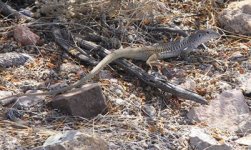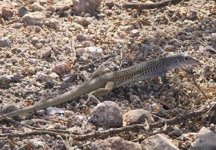| Range: |
 |
| Other Names: |
|
| Description: |
This is a rather large, boldly marked whiptail, with individuals reaching 4.25" SVL. Average size of 402 individuals from Southwest Hidalgo County, was 3.18" SVL and 15.5 grams. The dorsal scales are small and granular; there are 94-112 scales around mid-body. The well-defined striped pattern of hatchlings changes as individuals age, often producing a finely vermiculated dorsal pattern of small squarish blotches that obscure the original lined pattern. Larger individuals often have a conspicuous orange-brown coloration on the posterior half of the body, which may extend well onto the tail. Ventrally, the throat is light tan with a slight touch of orange and without dark spots. The chest is paler than the throat, with a few small black dots. The belly is cream or white and lacks any black markings. Juveniles have 10-14 cream or yellow longitudinal dorsal stripes on a black or dark brown background. |
| Similar Species: |
The finely vermiculated dorsal pattern of small squarish blotches and the conspicuous orange-brown coloration on the posterior half of the body in mature adults may help observers distinguish the Gray Checkered Whiptail. However, the species is easily confused with numerous sympatric whiptails. Until the casual observer becomes familiar with the subtle differences of these closely related species, only detailed examination of meristic characteristics of certain scales will help separate these species. |
| Venom: |
None |
| Habitat: |
Occurs in desert scrub regions of Creosote Bush flats with little undergrowth and sandy to gravely soils. |
| Behavior: |
Active individuals have been observed between April 5 and October 13. Activity is usually confined between 9:00am and 12:00 noon. When startled, Gray Checkered Whiptails may rapidly flee from an observer for a distance of several meters before they stop. |
| Hibernation: |
Underground during cool months. |
| Reproduction: |
All female species resulting from the hybridization of A. marmorata and A. scalaris. Average clutch size is 4. The eggs are creamy in color, elliptical and approximately .39" X .7". An adult captured on June 4 laid 5 eggs on June 5; 4 of the eggs hatched during the third week in September, Hatchlings are 1.25-1.41" SVL. |
| Diet: |
Termites, ants, beetles, spiders, beetle larvae, desert cockroaches, solpugids, robber flies and plant debris. |
Sources:


|











